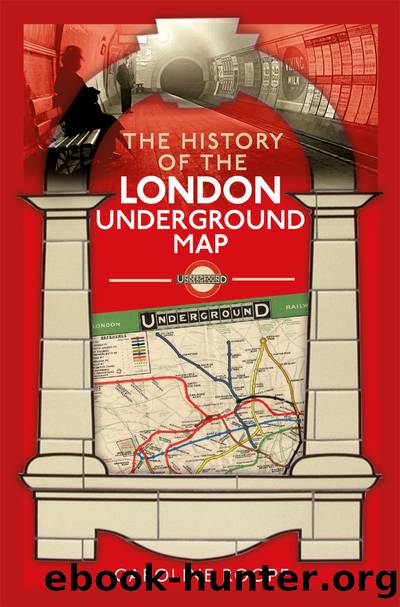The History of the London Underground Map by Caroline Roope

Author:Caroline Roope
Language: eng
Format: epub
Tags: TRANSPORTATION / Public Transportation
Publisher: Pen and Sword
Published: 2022-10-30T00:00:00+00:00
Evidently, Pick had found it amusing, and kept it as a memento.
Public engagement with the posters remained high, even though some of the Modernist representations only seemed to appeal to a select group of high-minded individuals. It was the cheapest form of modern art available â in the 1920s, copies were charged at between two and five shillings, dependent on printing costs19 â but rather than devalue the work, it did the opposite. With a healthy annual publicity budget of £90,000, and with £12,500 of this ring-fenced for commissioning posters, London Transport was able to attract the very best artistic talent, including a new crop of young British artists who had not previously worked for the UERL. These included Christopher Greaves, artistic partners Tom Eckersley and Eric Lombers, and Clifford and Rosemary Ellis.
In 1937, more posters were sold by the London Transport shop than in the previous four years put together. Popular choices featured landscapes, gardens and zoo animals, depicted in tempered Modernist style. These were safe subjects in uncertain times. By 1937, the political situation on the continent was deteriorating rapidly, and war loomed large following the Munich Crisis of September 1938. Cutting-edge styles were toned down in favour of escapism, as London Transport encouraged its passengers to Go Out into the Country (Graham Sutherland, 1938).
Art and design had well and truly permeated the capitalâs transport system, and as a result the metropolis too. Pickâs tireless pursuit of art, for the benefit of civilisation, transcended his everyday role at the helm of a large public utility, where his mind was often âa jumble of headlines and paragraphs about everything in particular but nothing in general.â20 In his pamphlet This is the World that Man Made, he would define art as âthe attempt of man to secure some semblance of beauty and harmony throughout his civilisation, to introduce order and meaning into the world he has built and fashioned for himself.â21
In September 1939, this statement would be put to the test with the announcement that Britain was at war with Germany. A year later, beauty and harmony would come under threat once more as civilisation tore itself apart, destroying the world it had made in the process. London Transport would keep the city moving during this challenging time, but Pick would mercifully miss seeing his adopted city â the city he had dedicated his working life to organise â reduced to rubble. He retired from London Transport in 1940, and after a short but unhappy time as director general of the Ministry of Information, he died at his home in Golders Green of a cerebral haemorrhage on 7 November 1941.
His will included a bequest to the Tate Gallery. The painting Ely (1926) by Francis Dodd is a suitably pastoral scene, depicting the cathedral under a blue summer sky. A horse and cart amble towards the town, passing a couple on a country stroll. Despite his obligatory acceptance of modern art, this was Pickâs idea of beauty â the âart of livingâ in visual form.
Download
This site does not store any files on its server. We only index and link to content provided by other sites. Please contact the content providers to delete copyright contents if any and email us, we'll remove relevant links or contents immediately.
| Automotive | Engineering |
| Transportation |
Small Unmanned Fixed-wing Aircraft Design by Andrew J. Keane Andras Sobester James P. Scanlan & András Sóbester & James P. Scanlan(32692)
Navigation and Map Reading by K Andrew(4972)
Endurance: Shackleton's Incredible Voyage by Alfred Lansing(4635)
And the Band Played On by Randy Shilts(2087)
Top 10 Prague (EYEWITNESS TOP 10 TRAVEL GUIDES) by DK(1903)
Wild Ride by Adam Lashinsky(1903)
The Box by Marc Levinson(1902)
The Race for Hitler's X-Planes: Britain's 1945 Mission to Capture Secret Luftwaffe Technology by John Christopher(1770)
The One Percenter Encyclopedia by Bill Hayes(1762)
Trans-Siberian Railway by Lonely Planet(1669)
Girls Auto Clinic Glove Box Guide by Patrice Banks(1657)
Looking for a Ship by John McPhee(1611)
Batavia's Graveyard by Mike Dash(1588)
TWA 800 by Jack Cashill(1570)
Fighting Hitler's Jets: The Extraordinary Story of the American Airmen Who Beat the Luftwaffe and Defeated Nazi Germany by Robert F. Dorr(1548)
Good with Words by Patrick Barry(1547)
Troubleshooting and Repair of Diesel Engines by Paul Dempsey(1534)
Ticket to Ride by Tom Chesshyre(1524)
Bligh by Rob Mundle(1523)
